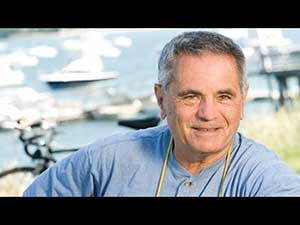Patient Stories
![]()
Dennis Korumpas spends more time at the gym than most people half his age. A familiar face at the Salem YMCA, the active 72-year-old puts in a good two hours of cardio and light weight lifting almost every day—often before dawn. He also teaches a number of spinning classes each week.

“Exercise has always been an important part of my life,” says Korumpas, a lifelong Salem resident and retired schoolteacher and guidance counselor. “I have a hard time sitting still.” But sit still is just what Korumpas had to do in the spring of 2013 when he began to experience pain, numbness and occasional weakness in his right leg.
At first the symptoms were manageable—he could still exercise and maintain most of his normal daily activities—but his ability to walk for extended periods of time began to slowly deteriorate. Things took a dramatic turn for the worse after Korumpas participated in a spin-a-thon at his gym in June 2013 and he knew he had to take action.
“Two hours after that spin-a-thon I could barely move,” he recalls. “I can push through most aches and pains associated with exercise, but this was on a whole different scale. I had severe pain shooting down my right leg and numbness in my foot and toes.” Tests quickly confirmed that the pain was emanating from his lower back.
Korumpas immediately booked an appointment with Michael Medlock, M.D., an NSMC neurosurgeon and spine specialist whom he had seen seven years prior for a different back problem. The diagnosis, he learned, was spinal stenosis.
“Spinal stenosis is a relatively common condition that involves the narrowing of the spinal canal and causes direct pressure on the nerves that travel through it,” says Dr. Medlock. “This can produce pain, tingling, weakness and numbness that radiates from the lower back down into the buttocks and legs—especially with activity.”
The most common cause of spinal stenosis is degenerative arthritis and disc disease. “As with other joints in the body, arthritis commonly occurs in the spine as part of the normal aging process and as a result of osteoarthritis,” explains Dr. Medlock. “This can lead to the loss of cartilage between the bones at the joints and the formation of bone spurs that rub against the nerves.”
As is the case with all of his spinal stenosis patients, Dr. Medlock initially took a conservative approach to Korumpas’s treatment, referring him to Kelly Pajela, M.D., one of three physiatrists who work in his Peabody practice.
“Surgery is always the last step in the treatment process, when we can no longer keep a patient comfortable by other means,” says Dr. Pajela. “My role with Dennis was to provide nonsurgical treatment options such as medication, physical therapy and teaching him how to modify his physical activities.”
This type of non-surgical treatment, she adds, can be maintained for extended periods of time—sometimes even years—before surgery becomes necessary. “But surgery is the only way to address the underlying problem, which is the pressure on the nerves,” says Dr. Pajela.
After four months, Korumpas decided to move forward with surgery. The procedure, called a lumbar laminectomy, involves the removal of the bone, bone spurs and ligaments that are compressing the nerves in the spinal canal. More than 80 percent of all patients who have this type of surgery will experience a significant improvement in their function and a markedly reduced level of pain and discomfort. Dr. Medlock performed Korumpas’s procedure at NSMC Salem Hospital.

Watch video on the NSMC YouTube channel
After two days in the hospital, Korumpas was back home and on the road to recovery. Gentle physical therapy led to light exercise and, within four months of slowly rebuilding his strength, he was back at the YMCA working out and teaching spinning classes again. “I was grateful that my life wasn’t in danger, but when you’re an active person like I am and suddenly you can’t walk 20 yards without pain? That’s no way to live,” says Korumpas. I’m really happy with my decision to have surgery and the progress I’m making every day.”

